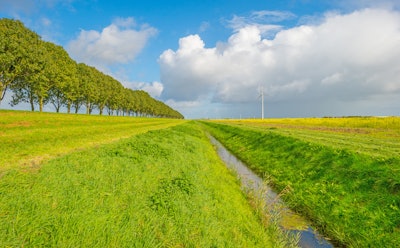
The U.S. Environmental Protect Agency has rolled back its rules governing wetland protection, with the changes leaving both environmental groups and construction associations dissatisfied.
The changes could still leave in play the regulation of “roadside ditches,” says the American Road & Transportation Builders Association.
ARTBA had cheered a decision by the U.S. Supreme Court in May that cut back federal regulatory authority of wetlands, particularly ditches, small wetlands and other minor waterways that don’t continuously connect to larger waterbodies.
But after the EPA released its new rule August 29 to comply with the court’s decision, ARTBA and other construction trade groups cried foul.
“After eight years of litigation, five contradictory regulatory actions spanning three administrations, hundreds of thousands of public comments, and one Supreme Court decision, EPA’s rule spurns the opportunity to deliver a lasting solution to protect the nation’s wetlands and brazenly hands this responsibility back to the courts,” said ARTBA President and CEO David Bauer. “We are back to Square One.”
The Associated Builders and Contractors said the EPA did not “fully implement” the court’s ruling.
“Instead, this rule, issued without meaningful opportunities for input from the construction industry and other stakeholders, will contribute to continued regulatory uncertainty and unnecessary delays for critical infrastructure projects across the nation.”
Environmental groups are upset as well, decrying it and the Supreme Court’s decision in the Sackett vs. EPA case that led to the new rule. They argue it leaves millions of acres of wetlands at risk for pollution.
“This rule spells out how the Sackett decision has undermined our ability to prevent the destruction of our nation’s wetlands, which protect drinking water, absorb floods and provide habitat for wildlife,” said Jim Murphy, National Wildlife Federation director of legal advocacy. “Congress needs to step up to protect the water we drink, our wildlife and our way of life. In the meantime, it will be up to the states to fill the gaping hole in water protections created by the Supreme Court.”
EPA’s New Rule
The EPA announced August 29 that the new rule amends the definition of the “waters of the United States,” which are subject to Clean Water Act regulation, to conform with the court’s decision.
The new rule takes effect immediately. The U.S. Army Corps of Engineers will determine which waters qualify for regulation.
“With this final rule, the Corps can resume issuing approved jurisdictional determinations that were paused in light of the Sackett decision,” said Michael L. Connor, assistant secretary of the Army for civil works.
EPA Administrator Michael S. Regan said he was disappointed by the court decision, but the rule will “provide a clear path forward that adheres to the Supreme Court’s ruling.”
The court’s decision centers on a section of the Clean Water Act, enacted in 1972, that calls for regulating pollution entering “the waters of the United States,” a term that is not defined in the act and has been the source of legal battles for decades.
In 2004, Idaho property owners Michael and Chantell Sackett sued the EPA after it ordered them to stop building a home on property the agency said had wetlands that needed to be protected.
According to the Sacketts, their property does not contain a stream, river, lake or similar waterbody. The Sacketts’ property has wetlands on it that are separated from other wetlands by a 30-foot-wide road. The wetlands across the road are connected by a manmade ditch that leads to a creek that leads to a lake.
In May, the Supreme Court ruled the Clean Water Act extends only to wetlands that have a “continuous surface connection” to “waters of the U.S.” and are “indistinguishable” from those waters. It also says the wetlands on the Sacketts’ property are “distinguishable” from nearby wetlands that feed into the lake.
What’s Next?
ARTBA says the rule remains confusing and “will likely perpetuate longstanding uncertainties.”
Its repeated comments to the agency that “roadside ditches be definitively exempt” were ignored, the association says. It also objects to the Corps of Engineers making permitting decisions, which it says will result in “delays and agency overreach.”
ARTBA says it is “working with industry allies to determine an appropriate response.”
Meanwhile, the EPA and Army Corps of Engineers have scheduled a public webinar for 3-4 p.m. ET September 12 to provide updates on definition of “waters of the United States.” The meeting will be recorded and posted on the EPA’s website after the event.
The two agencies also plan to hold “listening sessions” in the fall “with co-regulators and stakeholders, focusing on identifying issues that may arise outside this limited rule to conform the definition of ‘waters of the United States’ with the Sackett v. EPA decision.”











